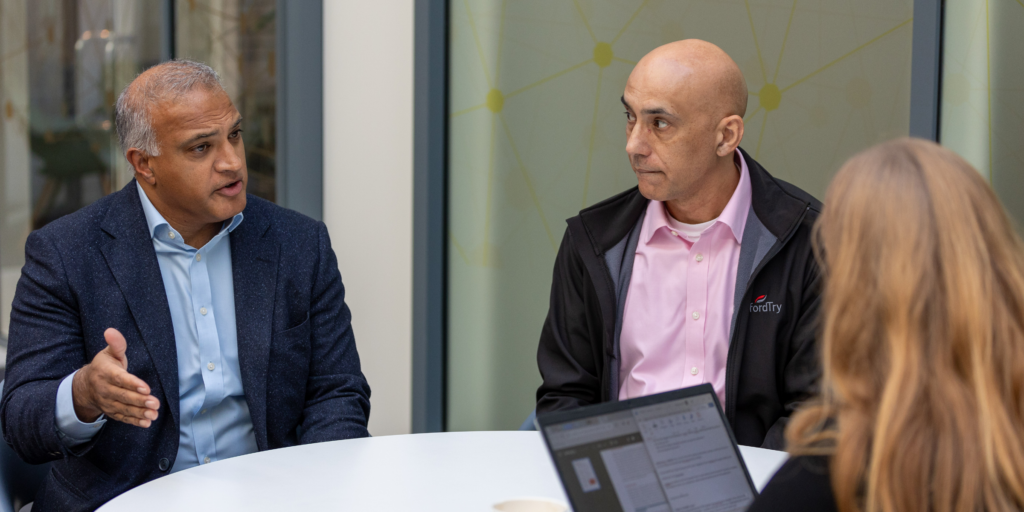Addressing process progress for profit from your most valuable resource. Enabling your people and your processes for optimum profit.
Digital HR and human capital management (HCM) applications are playing an increasingly major role in the whole ERP story. On the traditional HR side, more automation and self-service personnel tasks can take care of requests for time off, expense submissions, performance review information, regulatory adherence and much more. The result of freeing up this administration enables the reapportioning of human energy to work alongside business growth executives on HCM initiatives.
Digitalised HR clears the way for more engaged, analytical and demonstrably profitable HCM
With growing appreciation for the usefulness of artificial intelligence and machine learning in managing human resources, businesses are realising potentially untapped profit from personnel – both existing and those to be recruited in the future. The research firm, Gartner neatly packages HCM as workforce acquisition, workforce management, and workforce optimisation. It has also plotted a roadmap which estimates that by 2025 half of mid-market and large enterprises worldwide will have invested in a cloud-deployed HCM suite for administrative HR and talent management.
Closer to home, UK analysis in Deloitte’s Human Capital Trends 2019 report defines an HR cloud system as a ‘launch-pad’ rather than a ‘destination’. That study indicates that, while cloud systems have come a long way toward integrating the messy back office of HR, other requirements are still necessary to support innovation, raise employee productivity and reduce cost. It also suggests that organisations need to rethink their HR technology strategy sooner rather than later, consider cloud as a foundation, and explore new platforms as well as automation and AI-based tools to complement their core systems.
Organisations with agile HR are more likely to outpace the competition
According to Mark Judd – vice president of product strategy EMEA at Workday – an opportune time to start planning to boost efficiencies for managing your people resources is in the early stages of a wider business transformation. “An HR overhaul should be an integral part of the business’ strategic roadmap for creating a digital workplace. After all, in the age of digital disruption, organisations that have an agile HR function far outpace their competition.”
It’s worth noting that due to the many parts of HR, thankfully not all of it has to be tackled at once. However, Vincent Belliveau, chief executive EMEA at Cornerstone OnDemand said that to really deliver strategic value an organisation should focus on the transformational aspects of HR first and foremost, which in most cases means delaying the transfer of transactional systems to the cloud. Transactional HR, like payroll and time management systems, are important and need to work but it’s not these systems that transform a culture and drive business value. Transformational HR systems, such as learning, recruitment, performance management and analytics, are the crucial elements that create impactful people strategy and move the needle when it comes to an organisation’s success.
Judd also told us that a successful transformation requires a thoughtful examination of a company’s current state and potential future state. When looking to the future state of the organisation HCM requires an agile mindset that is led by HR but involves the entire organisation in continuous experimentation, he told us. He went on to highlight some of the key ingredients for success as a willingness to implement organisational change, alignment between HR and IT, and a strategic roadmap for creating a digital workplace.
“This is because HR digital transformation isn’t simply a question of redesigning processes. Organisations must address evolving work environments, flexible working arrangements, a volatile regulatory landscape, and tightening labour markets,” he said.
“The misstep many organisations make when deploying new technologies is to copy existing processes in the new system, rather than commit to complete HR transformation. There’s no room for complacency in today’s fast-paced business climate. To continue the upward curve for growth in the industry companies need to innovate using modern cloud services to transform their business, become more agile, and keep delivering fantastic customer experiences.”
How to engage people with new ways of working
The user experience is of equal importance when seeking more functional and streamlined HR processes. Getting frustrated with a clunky or unfamiliar interface or system can have pervasive negative effects on an employee’s psychological and physical well-being. Lauren Bidwell, Ph.D., HCM research scientist at SAP SuccessFactors said that self-service should save employees and managers time and energy, but that this is not always the case. In fact, she said, self-service solutions can cause significant frustration and wasted time if they are designed with cost-savings rather than a user’s needs in mind.
Last summer SuccessFactors conducted a ‘Manager Self-Service Experience Survey’ and found that one third of the respondents reported that using their company’s on-premise self-service functions left them feeling ‘ineffective’, ‘irritated’, or ‘frustrated’. Further, almost half of the participants (43 percent) reported wondering if self-service tasks could be done with less effort if things were organised differently.
Reverse mentoring for faster engagement
Change can be tricky to embrace, especially when the benefits of a better system seem elusive until tried. To help engage staff with new systems, Jon Wrennall – the CTO at
Advanced – offered the positive benefit impact when multiple generations of employees work alongside each other. Encompassing the traditionalists (born before 1945) through to the latest Generation Z (born after 1995), Wrennall explained that an effective way of kick-starting inter-generational working is by reverse mentoring. This is where the traditional image of the mentor is turned on its head so that senior or older members of the workforce are coached by the Millennials and Generation Zs.
The concept is in action at manufacturing company Neatcrown Corwen, a family-owned business in North Wales employing local people often spanning three generations. The company hired 24 year-old Dewi Prandle as a planning and procurement manager to spearhead the implementation of Advanced’s cloud-based ERP system, Business Cloud Essentials. With a natural aptitude for the ‘software mindset’ that is often associated with Generation Zs, Prandle is helping his colleagues across the organisation to adapt, adopt, and make the most of the new system.
“Forward-thinking businesses are responding positively to this opportunity to help drive innovations around areas such as digital technology. This is where HR can work hand-in-hand with IT to introduce new initiatives to engage employees with new technology from HR through to ERP for example,” said Wrennall.




